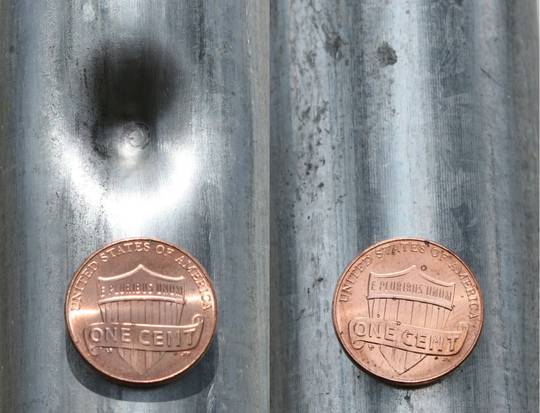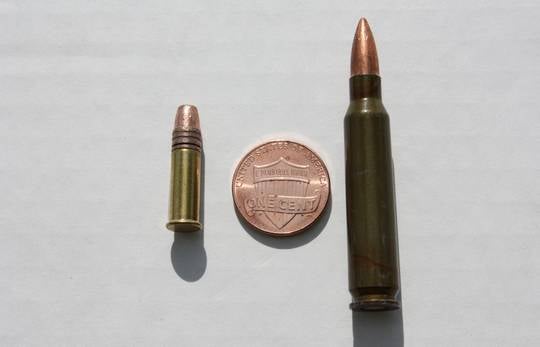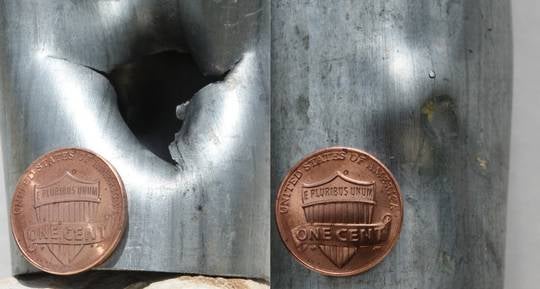[ This guest post was written by Aaron Spuler ]
So what exactly is the difference between the .22LR and .223 cartridges? Both can be fired out of rifles, and both can be fired out of pistols. Both have been used historically by civilian and military shooters. Both can be used for hunting (.22LR for animals such as rats, squirrels, rabbits, ground hogs; .223 for larger animals including coyotes, and in some states deer). Both are extremely popular rounds — .22LR is by far the most popular rimfire cartridge, and .223 is near the top (if not at the top) of the list of most popular centerfire cartridges.
Well, there’s one difference right there. Rimfire is an older design, which for the most part has been replaced with centerfire. Almost all ammunition used now is centerfire. With rimfire, the firing pin impacts on the rim of the case. With centerfire, the firing pin impacts in the center of the case. Fairly self explanitory. But it doesn’t really explain the differences between the two cartridges very well.
As mentioned above, rimfire is an older technology than centerfire. The .22LR cartridge was introduced in 1887, while the .223 cartridge was designed in 1964, specifically for use in the M-16 rifle.
Nearly a century separates the two cartridges, but what makes them different? Size-wise, the newer cartridge is slightly larger. The caliber of the cartridge measures the diameter (in inches). So the newer cartridge is 0.003″ larger in diameter — who cares? A human hair is from 0.003″ to 0.005″ in diameter. Is such a slight increase in diameter really going to make a difference?
Below is a cardboard pizza box shot with a .22LR bullet. The entry point can be seen on the left and the exit on the right. A penny is used for reference.
Now compare that to the same exact pizza box shot with a .223 bullet. Again, the entry point can be seen on the left and the exit on the right, and a penny is used for reference.
Not much visible difference, right?
Instead of a cardboard pizza box, this time the target is a 16-gauge metal pipe. Notice that the pipe is visibly deformed at point of entry (left), and there is no exit point. The .22LR bullet did not pierce the metal pipe. A penny is used for reference.
Now compare that to the same exact 16-gauge metal pipe shot with a .223 bullet. There is a well defined entry point, and the bullet’s copper jacket peeled off upon entry and stuck. Not only did the .223 bullet have enough energy to pierce the front side of the pipe, it easily pierced the back side of the pipe as well. A penny is used for reference.
To understand why the .223 bullet was so easily able to pierce both sides of the metal pipe, and why the .22LR bullet failed to pierce even the front side of the pipe, a few other factors need to be looked at.
Rimfire cartridges have for the most part been replaced by centerfire cartridges because the thin case walls of rimfires cannot handle nearly as high of pressures as those of a centerfire cartridge. Higher pressure means that the ejected bullet has more energy to deliver on its target because its velocity is greater.
The bullets also vary in size and shape. Availability for .22LR bullets varies from 36 to 60 grains in weight (2.3 to 3.9 grams), while .223 bullets range from 40 to 90 grains in weight (2.6 to 5.8 grams). The .22LR bullet is rounded while the .223 bullet comes to a sharp point.
The .223 cartridge contains significantly more powder than the .22LR cartridge (maximum pressure 24,000 PSI for .22LR; maximum pressure 50,000 PSI for .223). The .223 bullet is a much heavier bullet, travelling at a higher velocity. This means that the .223 bullet has much more energy to deliver on its target.
Upon impact .223 bullets demonstrate a tendency to tumble, increasing the size of the wound channel. The .223 bullet also delivers additional damage due to hydrostatic shock. The .22LR bullet has neither of these qualities.
The .22LR cartridge on the left, and the .223 cartridge on the right. A penny is used for reference.
For demonstration purposes, other calibers were shot at the cardboard pizza box and 16-gauge metal pipe. Entry point can be seen on the left and exit on the right. A penny is used for reference.
45ACP
 Your Privacy Choices
Your Privacy Choices












